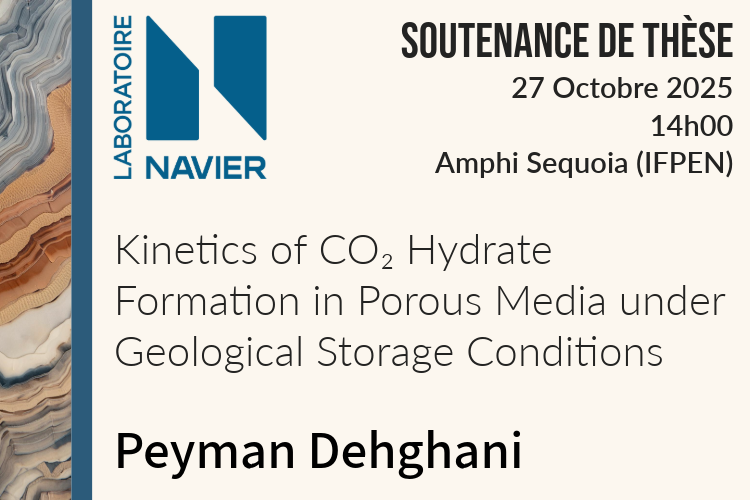
Soutenance de thèse – Peyman Dehghani
- Post by: Mathias Lebihain
- 21 octobre 2025
- No Comment
Peyman Dehghani, doctorant au sein de l’équipe Géotechnique soutiendra sa thèse « Kinetics of CO₂ Hydrate Formation in Porous Media under Geological Storage Conditions » le lundi 27 octobre à 14h00 dans l’amphithéâtre Sequoia à l’IFPEN (Rueil Malmaison).
Composition du jury :
- Prof. Daniel Broseta (Université de Pau et des Pays de l’Adour) – Rapporteur
- Prof. Lionel Mercury (Université d’Orléans) – Rapporteur
- Dr. Anthony Delahaye (INRAE) – Examinateur
- Dr. Anh Minh Tang (Ecole Nationale des Ponts et Chaussées) – Directeur de thèse
- Dr. Anne Sinquin (IFPEN) – Co-encadrante de thèse
La soutenance sera diffusée au lien suivant : Microsoft Teams
Résumé de la thèse
Afficher le résumé
This study presents a comprehensive experimental investigation into the formation, propagation, and dissociation of CO₂ hydrates across multiple scales, ranging from pore-level microfluidics to sediment-scale coreflood systems, with direct implications for geological CO₂ storage. In the microfluidic experiments, two high-pressure chips with distinct geometries were employed: a serpentine chip, which facilitated the generation and observation of multiple CO₂ droplets and bubbles, and a trap chip, designed with 70 serially connected traps to immobilize droplets under controlled static and dynamic CO₂ flow conditions. The onset, growth, and propagation of hydrates were systematically analyzed under both gaseous and liquid CO₂ conditions. Using the serpentine chip, the effect of water salinity was systematically studied with varying NaCl concentrations under static conditions. The trap-chip experiments focused on the nucleation of hydrates within water droplets exposed to dynamic CO₂ flow.
At the sediment scale, dynamic CO₂ injection experiments were conducted in a custom-designed sandpack cell equipped with pressure sensors, differential pressure sensors, and flow control systems. To characterize the internal state of the cell at various stages—including after initial sand packing and saturation, hydrate formation, and hydrate dissociation—medical CT scanning was utilized.
This multi-scale approach establishes a mechanistic connection between hydrate formation observed in microfluidic systems and that occurring in porous sediments, offering valuable insights into the nucleation and growth of hydrates.


